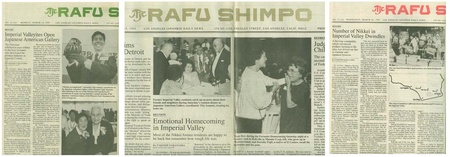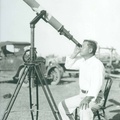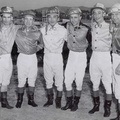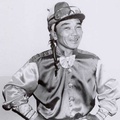My grandfather passed away when I was four years old. My only memories of him are from when he was already bedridden and deathly ill. At that time, my father would take me for a ride to the post office in Westmorland every morning where we picked up our mail since we lived on a farm and there was no rural delivery. On our way home, we always stopped at my grandmother’s house to drop off her mail. As my dad sat down at the kitchen table for a cup of coffee or tea with my grandmother, he would hand me two newspapers rolled up in small white paper sleeves on which our address was stamped in red, and would say, “Take the newspapers to Grandpa.” In his condition, there was no way my grandfather could read, but it was my dad’s way of seeing to it that I had some interaction with my grandfather. I would tiptoe into his bedroom and say “Hi Grandpa” as I tossed the Rafu Shimpo up onto his bed.
The Rafu Shimpo was established in Los Angeles in 1903, the year before the first Issei pioneers settled in the Imperial Valley. The fledgling periodical faced stiff competition from well-established Japanese newspapers in San Francisco—the Nichibei Shinbun and Shin Sekai. Even though those two publishers maintained offices in Los Angeles, their papers were shipped from San Francisco by train and it took two days for them to reach Southern California. With the outbreak of the Russo-Japanese War in 1904, the growing Japanese immigrant community in Los Angeles became anxious to get current news, and in the aftermath of the San Francisco earthquake of 1906, the Rafu Shimpo soon outpaced its northern California rivals.
The first page of English appeared in the Rafu Shimpo in 1917. The English section was formally established nine years later with English print appearing only weekly. As the Nisei generation grew in number and maturation, the English section became a daily feature beginning in 1932.
The Rafu Shimpo and other Southern California Japanese American vernaculars, including the Kashu Mainichi and even an agricultural journal called the Nanka Sangyo Nippo, not only provided information in a language that the Issei could read, but for the Nikkei community in the remote Imperial Valley they also served as a vital link to the “outside world.” Conversely, it kept those in other areas abreast of the goings on in the Imperial Valley. During the 1930s, Kumezo Hatchimonji, an Issei graduate of Columbia University and prominent seed man, wrote a regular column for the Japanese section of the Rafu Shimpo on farming practices in the Imperial Valley. Most of his articles were highly technical covering the production of tomatoes, lettuce, cantaloupes, and other melon varieties. K. Hatchimonji also addressed labor issues and other aspects of the region’s agricultural industry.

A Rafu Shimpo article, dated Jan. 2, 1942, announces the tragic murder of Mr. & Mrs. Kikuchi in Brawley. Three months later, the Rafu Shimpo ceased publication and the Japanese type was hidden under the floorboards of its building for the duration of the war.
The newspapers also served as a creative outlet for the literary talents of the Issei. For example, from her Westmorland farm, Hamako Nakamura, the mother of renowned playwright and author Wakako Yamauchi, routinely submitted poetry, which was published in the Kashu Mainichi. (After the war, Brawley-Nisei Junko Maruya would become managing editor of the Kashu Mainichi.)
The Rafu Shimpo, in particular, was well connected to the Imperial Valley. According to its 1940-1941 Yearbook and Directory, the newspaper company maintained a correspondence branch office in Niland. And historically, the Rafu Shimpo’s ties to the area ran deep. Two of its early publishers were involved in farming in the Imperial Valley. The third owner, Masao Kanno, and his partners reputedly grew 10,000 acres of cotton around Calexico in 1916. Henry Toyosaku Komai, the grandfather of the present publisher, Michael Komai, started out as a labor contractor in the Imperial Valley and farmed 250 acres of cantaloupes before going into the newspaper business.
Looking through my grandfather’s old ledger, I found that he paid eleven dollars for his annual subscription to the Rafu Shimpo in 1939. Except for the period between 1942 and 1946, we have been getting the Rafu Shimpo without interruption at our same post office box for the past ninety years. But I worry about how much longer will it be coming?
After World War II, the Rafu Shimpo became the most widely circulated Japanese American newspaper. In 1946 it had approximately five hundred subscribers. Thirty years later the Rafu Shimpo’s circulation exceeded twenty thousand. But today, the paper’s circulation is only half of that, and its very survival is at stake. The Rafu Shimpo faces the same problems that the entire newspaper industry is struggling with (competition from the internet, increasing costs, mounting debt, declining readership, and plummeting revenue), but there is the added challenge of being a Japanese American newspaper.
While ethnic media—especially Asian American publications—are thriving, Japanese American vernaculars have not fared as well. The Kashu Mainichi fell by the way side many years ago, and more recently the closure of San Francisco’s two remaining Japanese American dailies, the Nichibei Times followed by the Hokubei Mainichi, leaves the Rafu Shimpo as the last daily Nikkei newspaper in the United States.
What is it about the present-day Japanese American community that makes it so tough for its ethnic media? Part of it is that roughly three-quarters of the Nikkei in California are native-born (the highest ratio among Asians in America), meaning that we are no longer dependent on a foreign-language source of news. This demographic factor should be of concern to the Rafu Shimpo with its sometimes four pages of English versus eight pages of Japanese. More damning, perhaps, is that most sansei and yonsei seemingly do not feel an affinity to an ethnic newspaper. This issue of apathy to ethnic identity and cultural heritage among the younger generations is a dilemma that virtually all Nikkei organizations are facing—the Japanese American Gallery included.
News of the Rafu Shimpo’s problems and last year’s alarming closure of the Hokubei Mainichi spurred Iku Kiriyama of the Japanese American Historical Society of Southern California to organize a town hall forum to brainstorm ways to sustain the newspaper. Nearly a hundred concerned supporters attended the “Save the Rafu” forum at the Japanese Cultural Institute in Gardena on January 17, 2010.
To many individuals in the Nikkei community, the “Rafu” is more than a business or just a newspaper. As Iku put it, “It’s a community treasure.” When interviewed by the Pacific Citizen, former English editor of the Hokubei Mainichi, J. K. Yamamoto, remarked that “the ethnic media still serve an important function that the mainstream press can’t fill.” The Rafu Shimpo is important to Japanese Americans because it gives us a voice and it reminds us of—and strengthens—our cultural heritage.
From a curatorial perspective, the Rafu Shimpo has been extraordinarily valuable in another way. In her March 1, 2010, Los Angeles Times article, “L.A.’s Little Tokyo looks to save struggling newspaper,” Teresa Watanabe stated that “the Rafu became the nation’s largest and most important newspaper to chronicle Japanese American community life.” The old newspapers are a treasure trove for scholars, students, and researchers. The San Diego State University Library has both the Rafu Shimpo and Kashu Mainichi on microfilm dating back to 1914 and 1931, respectively. I spent many weekends and countless hours at the library; much of the information about past events that I gleaned from the periodicals can be found in the captions and text-boards on display in the Japanese American Gallery.
Teresa Watanabe also poses the question: Who else will cover Nikkei activities and events? The Japanese American Gallery knows firsthand the importance of media attention. Because so few Nikkei families returned to the Imperial Valley after the war, we started our museum project in the early 1990s with the understanding that most of the support that we needed to realize our objectives would have to come from outside the county—much of it from Los Angeles. During those early days, the Rafu Shimpo played a crucial role in getting the word out. And over the years, it has always been more than willing to print the press releases that I have sent in and it has publicized all of our gallery’s activities, whether it was the Japanese Evangelical Missionary Society tour or the William Tokeshi Art Show.
I can say unequivocally that the Rafu Shimpo is a contributing factor to all of the successes of the Japanese American Gallery. Japanese Americans need the Rafu Shimpo and the Japanese American Gallery needs the Rafu Shimpo. We need to keep it alive. If you are not already a subscriber, please consider supporting our last Japanese American daily newspaper. Better yet, if you are a Nisei, admonish your children and grandchildren to subscribe!
To inquire about subscriptions, contact:
The Rafu Shimpo
701 E 3rd St, #130
Los Angeles, CA 90013-1789
(213) 629-2231
Online Subscription >>

Who else is going to cover activities and events that are uniquely Japanese American? The Rafu Shimpo featured the March 12, 1994, opening of the Japanese American Gallery in a three-day series on its front page! Our local newspaper, The Brawley News, opted not to report on the event.
*Additional sources for this article: “Focused on Rafu’s Future” by Mikey Hirano Culross in the Rafu Shimpo (January 20, 2010); “Pondering the Fate of Ethnic Media” by Nalea J. Ko in the Pacific Citizen (February 5-18, 2010).
** This article was originally published on the Teikoku Heigen News: Newsletter of the Japanese American Gallery (Spring 2010, Number 24).
© 2009 Tim Asamen





